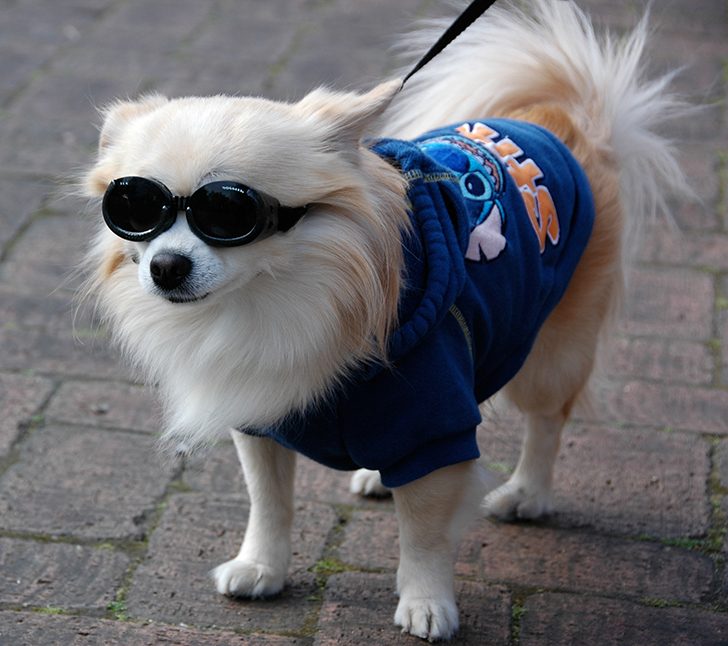 Japan’s affluence grew in the late seventies and throughout the eighties. Hordes of people moved out of their cramped apartments and into more palatial dwellings. With the dream houses and condominiums came the pets – a surefire way of announcing to your friends and neighbors that you were in the money. And so started Japan’s ‘pet boom,’ which, despite the recession, still flourishes today.
Japan’s affluence grew in the late seventies and throughout the eighties. Hordes of people moved out of their cramped apartments and into more palatial dwellings. With the dream houses and condominiums came the pets – a surefire way of announcing to your friends and neighbors that you were in the money. And so started Japan’s ‘pet boom,’ which, despite the recession, still flourishes today.
Nothing screamed wealth like owning a dog, and as the pet boom kicked off, people came to the conclusion that the bigger and more exotic the dog, the better. After all, why drive a Honda when you can import a Lamborghini? First time home owners simultaneously became first time dog owners, and the breed du jour of the eighties, somewhat inexplicably, was the Husky.
The first few years of the pet boom ended in tragedy, not just for thousands of Huskies that were being carted away from pet stores to live in high-rise, humid cities utterly unsuitable for a breed with an innate desire to run hundreds of miles a day, but also for other breeds that caught the pet boomers off guard with their tendencies to, unforgivably, behave like dogs.
Barking, shedding of hair and the inexplicable need for regular feeding and walking came as a shock to many newbie dog owners, as did the fact that little cute furry Huskies grow up to be very large furry Huskies. As a result the cities’ gas-chambers were overflowing with unwanted dogs, and those that weren’t executed were dumped in the countryside and left to roam, often ending up in the crosshairs of farmers’ rifles.
BRED TO DEATH
Fast-forward a quarter of a century or so and it’s hard to believe that Japan has a dog problem, what with all the pet shops, grooming parlors, dog cafes and the increasing number of emporiums featuring the latest in designer dog apparel and accessories appearing in the cities’ chicest areas.
For many, perhaps, the only obvious “issues” in Japan are that dogs have pads on their paws so they don’t need shoes. Similarly, they have fur so are really already wearing their clothes and don’t require a Louis Vuitton jacket. However, the dogs being pushed around in baby buggies should count their blessings, because despite nature giving them four healthy legs, they don’t even have to walk to be fabulous.
Sadly, the facts remain thus: some 300,000 abandoned dogs are exterminated at the hands of local authorities each year, and animal shelters are inundated daily with dogs that have outgrown their cutesy puppy years and no longer cause troupes of high-heeled tweenies to cry out “kawaii!” in unison. Who’d have thought dogs get old too?
The figure of 300,000 canine terminations only represents state-sanctioned culling, and according to animal rights campaigners and activists the real figure could easily be quadruple this. Wishing to be known only as “Serena” and neither confirming nor denying that she is of Japanese origin, Serena has more than scratched the surface of Japan’s dubious dog trade, as she explains.
“I spend most of my time in Japan in Tokyo, Osaka and Nagoya and frequently visit connections I have in Australia, New Zealand and the UK,” says Serena, who’s in her late twenties.
“It’s not just about dogs, it’s animals in general, but if people know a little more about the dog situation they might sit up and take notice of other issues of grotesque animal cruelty going on right under their noses, and not just in Japan,” she adds.
Serena is passionate, oozes street-smart intellect and denies that she’s an ‘activist’ of any kind, describing her plight as one of simply “drawing attention to certainissues involving animals.” She’s clearly ticked a few people off that aren’t used to being ticked off, and actually had to leave the country at one point as she feared for her life, but assures me “it was worth it.” She’s not wearing sandals, isn’t a vegan, doesn’t have dreadlocks and her bag is not made of hemp – in fact she’s attractive, somewhat petite and fashion-conscious – looking at her, it’s slightly hard to fathom how this diminutive young lady managed to get herself arrested four times.
Listen to her speak, however, and it soon becomes clear. What also becomes abundantly clear is that she is one of the good guys. Is she misguided? Definitely not, although her actions may be. She’s been down the road of politics and bureaucracy and got nowhere, so decided to chart a different, more proactive tack.
“I guess most normal people think dogs are just cute and cuddly, and see them being pampered by their owners on the streets, so there’s no reason for them to think there’s a problem. But there is. Those cute and cuddly dogs came from mafia-owned pet stores, and although the facades of these stores seem reasonable; relatively clean, with fairly knowledgeable staff who seem to like animals, what goes on behind the scenes is worse than despicable,” she asserts.
“Firstly these stores are connected to illegal breeding farms that import “fashionable” breeds like Chihuahuas, Toy Poodles, Miniature Daschunds and basically any other breed that is cute and will sell – you know the types I mean. The dogs are imported from unscrupulous breeders from everywhere you can imagine; from the UK and Germany, to Mexico and even Cuba. While the pet shops in high traffic areas like Shinjuku, Ikebukuro and Roppongi (in Tokyo) appear respectable, the breeding farms are squalid, cramped hell-holes where a single bitch is forced to breed until she dies from exhaustion or is killed if
her litters become too small. And when I say killed, I don’t mean humanely. I mean suffocated, drowned or if they’re lucky they’ll have their throats slit and be left to bleed out.”
“Many of the litters result from deliberate inbreeding without a second thought given to the health of the litter, or its prior lineage. Over the years I’ve documented hundreds of these farms and not once have I seen a sterile, cordial environment – it’s always the same: sadness, mental illness, disease, abuse and more abuse. However, due to the mob connections, the police won’t do a damn thing. That’s where we come in,” says Serena without elaborating.
PRO LIFE
It will probably come as no surprise to seasoned urbanites that where there is sleaze and disrepute, there are pet shops. Take the Kabukicho area of Tokyo, for example. Let’s face it, there isn’t much that can’t be bought there. The same goes for similar districts.
In recent years, it was widely reported that hapless salarymen – lacking the guidance of a moral compass – adorned their money-shrewd hostesses with designer goods to win their affection. These men were seemingly oblivious to the fact that multiple other ‘hopefuls’ were purchasing exactly the same products for the business-savvy belles, who would then keep one of the original items for themselves, returning the others to the shop for a cut of the original price. It goes without saying that these shops, conveniently located at regular intervals around red-light districts and staying open until sunrise, were in cahoots with the clubs the girls work for.
Trade “bags” for “dogs” and the picture remains the same today. Dogs have effectively become the new currency in some salacious areas. Toy Poodles sometimes fetch upwards of 500,000 yen. The animals are invariably returned the next day to be ‘re-sold’, so the profit margins for the girls, the clubs and the stores are wide.
The fact that Japan’s Animal Protection and Control Law passed in 1973 has been dubbed the ‘sieve law’ (due to it not only being largely unknown by local authorities and police, but also legally unenforceable), means that only a handful of heinous acts against animals are being punished with negligible fines, which rarely exceed 30,000 yen (less than the fine for stealing a bicycle).
Some organizations are beginning to take a stand, however. The municipal animal protection center run by the city of Kumamoto has sparked a recent trend of state and private organizations trying to curb the growing numbers of pets, especially dogs, being abandoned or offloaded on shelters or municipal centers to “take care of them.”
Since 2006, the center in Kumamoto has refused to unconditionally accept unwanted pets just because they have become a nuisance. Instead, the center officials try to talk the owner into keeping the pet, and when all else fails, will insist the owner is present when the lethal injection in administered.
“It is easy to kill animals at the request of owners,” said Masayoshi Matsuzaki, director of the Kumamoto center. “But we want people to know how serious it is to take an animal’s life, even if that distresses the owner.”
The new stance taken by the Kumamoto center has seen the number of animals it’s been forced to destroy fall drastically, as owners can no longer be physically detached from the process of having their pets eliminated.
The Kumamoto center has had remarkable success with its animal adoption program too, which has inspired a number of other local authorities to look for alternative solutions rather than simply bowing to the demands of owners inconvenienced by their pets.
The Saitama prefectural animal guidance center launched a project to find homes for abandoned dogs and cats in a tie-up with a pet shop, a move that is slowly catching on with other pet shops, some of whom are offering free adoption and even ‘fostering’ programs for unwanted pets in a bid to keep them from life-ending injections and gas chambers.
Pecos is a pet store in a major shopping mall in Koshigaya, Saitama prefecture. Part of the store is sectioned off and named “Life House” in the hope that as many lives as possible can be saved through the store’s free adoption scheme. In this part of the store there are no exorbitant price tags, just signs saying “I am waiting for a second partner.”
Unlike more unscrupulous pet stores, Pecos takes responsibility for determining a prospective owner’s suitability to pet ownership through a series of pointed questions, a process Serena herself champions.
“I don’t want people to think that Japan’s pet issue is any worse than in any other developed country, because it isn’t. In fact 98 percent of dog owners in Japan take good care of their pets. We’re talking about a minority of owners who are ignorant, ill-informed, lazy or emotionless – the real problem is the industry itself. It’s corrupt and devious, and goes hand-in-hand with a bigger picture of government double-dealing and hypocrisy, but every small battle we win takes us a step closer to winning the war.”
“Adoption and fostering programs for pets are great. It gives them a second chance of having the life they deserve and the pet stores, shelters and even municipalities involved in these schemes should be applauded, not for the system itself (such systems have existed for years in the West and should be common sense), but for doing it right. For vetting people and doing background checks for suitability.”
“Whether you buy one from De Beers or kill for one in the Côte d’Ivoire, a diamond is still a diamond. The difference is whether or not you understand why you have blood on your hands,” surmises Serena analogically.
Story by Jon Day
From J SELECT Magazine, April 2010















Recent Comments